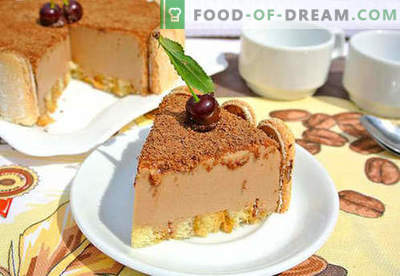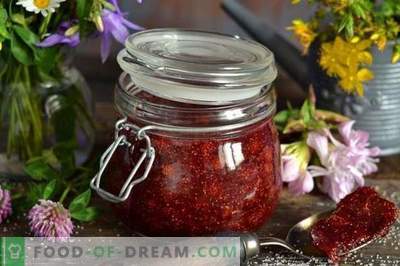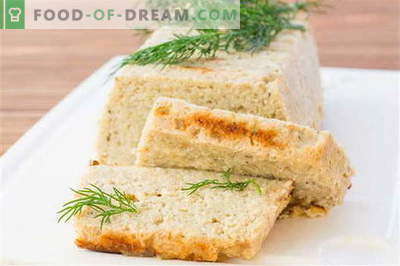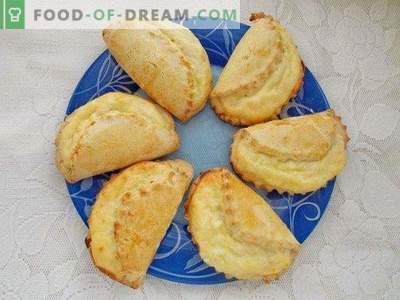
Soufflé is a tender dessert on gelatin or agar-agar, it pleases with its pomp and light taste, but it does not always work that way. Sometimes it just does not freeze, reminds semolina or something else. There are also options for a hot souffle that is baked in the oven. This dish is not all that simple either. Disassemble common mistakes?
Why can't the agar-agar soufflé
A sweet souffle without baking in the classic version is made on agar-agar. This is a powder that must be prepared in a special way. You can find a variety of instructions: insist a few hours, boil a minute or five, cook immediately in syrup or exclusively in water. Who is right? Need to focus on the instructions. Modern agar-agar often does not require many hours of soaking, it is simply mixed with water and boiled.
Why the souffle on agar-agar does not freeze:
- The proportions of products are violated. In addition to the recipe, it is desirable to coordinate the quantity with the instructions on the package, often the values diverge. It makes more sense to focus specifically on the manufacturer.
- Disrupted technology. If the recipe says to boil the agar-agar for five minutes, then we will definitely note the time, stir it, do not move anywhere.
- There is no acid. It is necessary to add a little lemon juice in the souffle, it stabilizes the consistency.
It is believed that the souffle on agar-agar should harden even at room temperature. This is true, but still it is better to put the dessert in the fridge; there it will get stronger much faster. In addition, if you plan to pour chocolate souffle on top, it is preferable to have a cold base.
Why is it impossible soufflé on gelatin
Very often the soufflé is cooked on gelatin. This is done in order to save or in the absence of agar-agar. There is nothing wrong with gelatin, if you put it in the norm and prepare it correctly beforehand. Even an instant product needs to stand for ten or fifteen minutes. If ordinary gelatin is used, it is better to leave it for 40-60 minutes.
Gelatin handling errors:
- Dilution with hot water. As a result, lumps, clots immediately appear, which then do not dissolve.
- Boiling. Gelatin is heated to a liquid state in a water bath, it is impossible to boil.
- Not filtered. Gelatin when added to the souffle must be filtered to remove small lumps and dense clots, dried crusts.
- Fast lead. Melted gelatin is added at the very end and in an extremely thin stream.
Gelatin is not whipped with the other ingredients for a long time, but it is important to carefully combine them. Otherwise, the soufflé will exfoliate, moisture will appear on the surface, and the dessert will harden badly.
Why is the souffle tight, tough
A good souffle has a fluffy and porous texture, it is airy and light. Even a few proteins can make a whole cake. If the mass is dense, tight, looks like a frozen semolina porridge, then obviously something went wrong. Most often the problem is in proteins. They need to be very well whipped to foam.
Why don't whites whites:
- not fresh eggs;
- dirty dishes or beaters;
- the yolk has got to squirrels;
- sugar added immediately.
According to the rules, you need to whip in a clean, preferably even fat-free, container until the proteins are densely foamed, only then introduce sugar syrup. If sand or powder is present in the recipe, they are introduced after the proteins thicken.
Otherwise, dense peaks are not achieved. Unlike agar-agar, this product requires a refrigerator. It will not freeze at room temperature. It also takes much longer, sometimes the souffle hardens completely only after five or six hours. Therefore, professional confectioners do not like to work with gelatin.
Why the souffle is not sweet, not tasty
It happens that the cooked mass is tasty and sweet, and the frozen soufflé is no longer so saturated, it is watery, something is missing. In fact, this is the case with all desserts. After cooling, they are not so sweet, the flavor is less pronounced. You can even compare with ice cream. In melted form, it is much sweeter and more fragrant.
What to do? Just add more sugar to the syrup. For the fragrance, it is imperative to pour in vanillin, inject grated zest or some essence. It is necessary to make the cream slightly sugary, so that after hardening it will not lose its pleasant taste.
Why baked soufflé fails.
Soufflé is not always a dessert. Often it is a hot meat, cottage cheese or vegetable dish. It also belongs to the French cuisine. Despite the same name, there is a huge difference in technology. Both types of soufflé are united only by beating. Baked soufflé also does not always work. The main problem - it falls off after preparation. As a result, instead of an airy and delicate dish, we get a rubber casserole.
To the souffle from the oven does not fall:
- Bake the soufflé right after cooking and adding the eggs. The mass should not stand for a minute, so we turn on the oven in advance, let it warm up well.
- Proteins are added to the mass at the very end and only in a well-whipped form. They need to be brought to dense peaks.
- It is impossible to spread the mass in the form to the very top. There should be at least two centimeters of free space. Souffle is not cupcakes, it should not look out with a cap.
- A soufflé is best lifted and baked in conventional forms with straight walls without bulges and bends. Figured dishes are undesirable.
- After baking, you cannot immediately remove the souffle from the oven. First, let us stand in it, slightly opening the door. As soon as the mass is strong, cool slightly, you can pull out the dish.
- Often the souffle falls, as it was not corny baked inside. The temperature and cooking time depend on the ingredients and the recipe itself.
Good advice! To get a fluffy and airy soufflé that does not fall in the oven, you can add an additional one or even two proteins. Naturally, beat in a dense foam.
If you believe French cooks, then the souffle should fall off. But the weight drops by about 1.5-2 centimeters. Naturally, if the dish is low and laid out in a wide shape, then it will turn into a flat pancake.
It is advisable to pick up suitable for cooking dishes with high sides of four centimeters.






























